The Amalfi Coast…probably one of the most perfect and idyllic travel destinations you could ask for. This UNESCO-listed site is comprised of 13 towns and villages, and is a stretch of coastline on the Tyrrhenian Sea. I’ve been to the Amalfi Coast twice now and am itching to go back a third time…and a fourth…and a fifth….because there’s nothing better than sitting on a terrace overlooking the rocky, colorful Italian coastline and sipping a bubbly Aperol Spritz. This Amalfi Coast travel guide has been a long time coming, and I’m so excited that I finally found time to put it together. A word of warning – this might be one of my longest posts yet as there are a lot of places to cover; you can easily jump from section to section using the Table of Contents below.
How to Get to the Amalfi Coast
The easiest way to get to the Amalfi Coast is by catching a flight to Naples. You can also reach the Amalfi Coast by taking a boat from Sorrento (although, if you’re traveling to the coast from anywhere else within Italy, you’ll still likely need to take a train from Naples to get there). Once you’re in Naples or Sorrento, you can easily get around via public transportation (either by ferry or public bus). I wouldn’t recommend renting a car as the roads along the Amalfi Coast are extremely narrow, and parking is a nightmare!

Where to Stay on the Amalfi Coast
You can choose a single base, or hop around the Amalfi Coast like we did. Since we wanted to make the most of our trip by visiting as many towns as we could, and it was relatively easy to get from one town to another, we spent two nights in Naples, one night in Sorrento, two nights in Positano, and two nights in Amalfi. I’m really glad we broke up our nights the way we did because every town we stayed in offered a very different vibe. If you don’t want to bother with luggage or checking in and out of different hotels, then I would recommend Positano as your main base due to the town size and central location.
Best Time to Visit the Amalfi Coast
The best time to visit the Amalfi Coast is during the shoulder season months of May or September; you can expect fewer crowds but beautiful weather during these times of the year. Summer months are also good, but they also bring high prices and lots of tourists (it’ll be difficult to nab a sun lounger, and the buses will be crowded!).
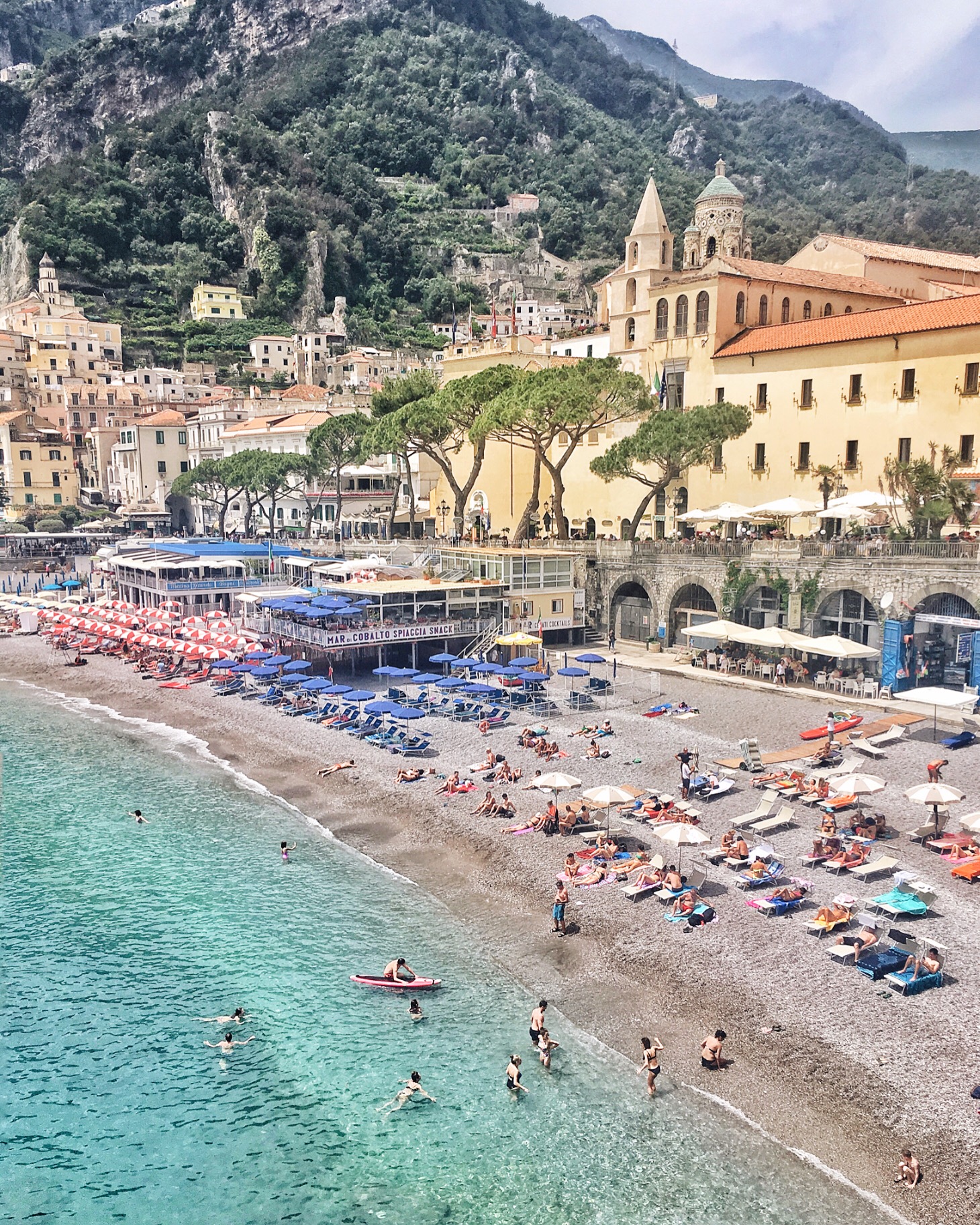
How Long to Stay in the Amalfi Coast
I would stay in the Amalfi Coast for at least a week if possible. There really is so much to do and see, and the last thing you want to do is rush through the towns and not enjoy your trip! If you’re REALLY short on time and only have 2-3 days to spare, you can shave off part of this itinerary by skipping Naples and Amalfi, and focusing your trip on the towns of Sorrento and Positano.


Where to Visit on the Amalfi Coast
With so many little villages and attractions to choose from on the Amalfi Coast, it can be quite daunting to try to plan out an itinerary of where to go. This ultimate Amalfi Coast travel guide will cover my recommended stops along the Amalfi Coast, including Naples, Sorrento, Procida, Positano, Capri, and Amalfi.
Naples
What to do
Naples is a popular starting point for those visiting the Amalfi Coast. While it’s not technically part of the Amalfi Coast itself, it is the closest large transportation hub, so it’s likely you’ll have to pass through Italy’s 3rd largest city. It’s a ‘love it or hate it’ type of city – super busy, crowded, chaotic, and full of character.
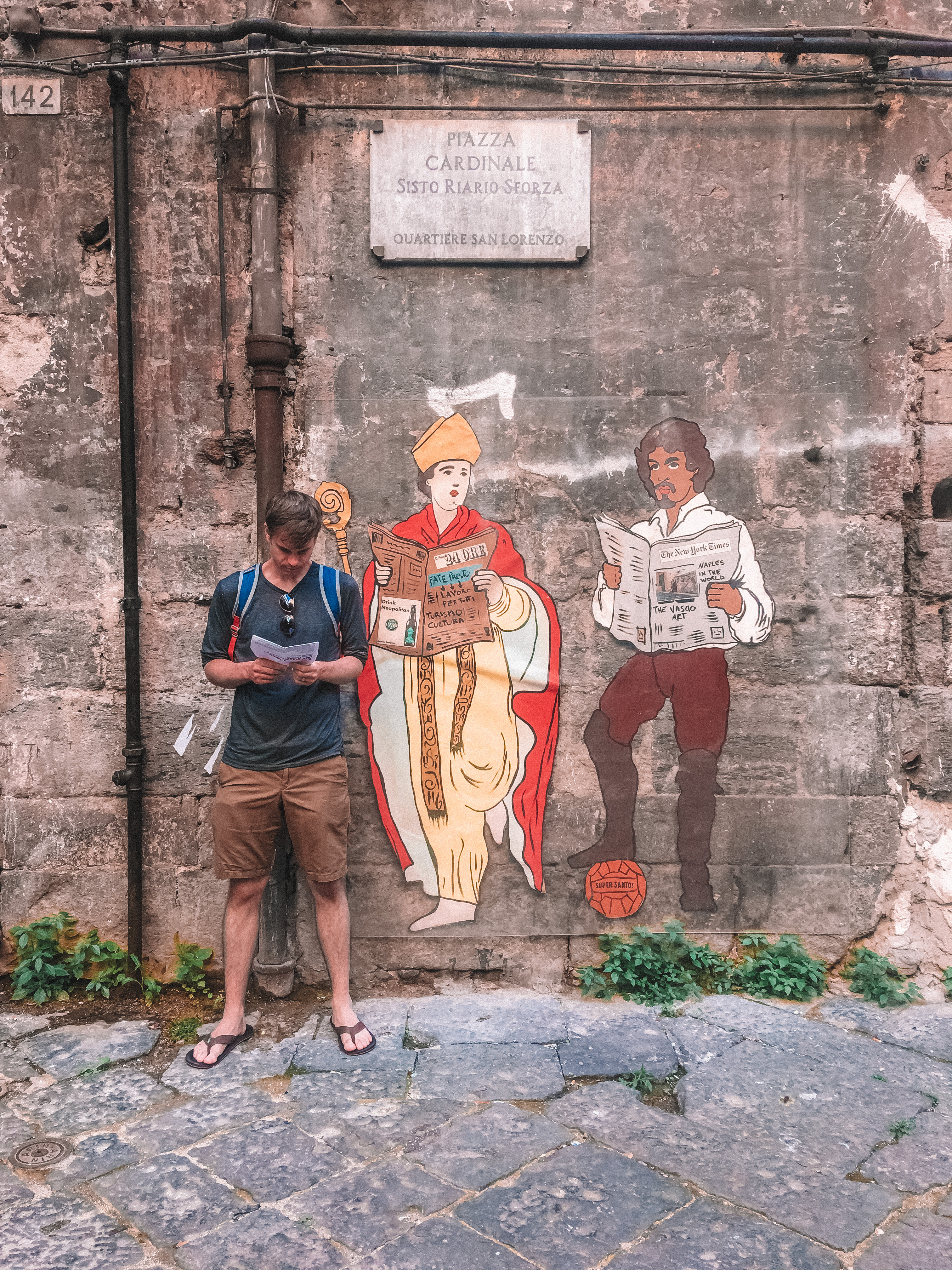

The streets are vibrant and humming with life, and the buildings have a gritty, tattered, but romantic character to them.




Visit the Piazzo del Plebiscito which is majestic pedestrian square in the heart of Naples. Make sure to check out Castel Nuovo, a large fortress near the harbor with a large collection of paintings and frescoes from the 14th to 19th centuries.

TIP: For a no-frills stay in a convenient location, check out the Correra 241 Lifestyle Hotel. We chose this place because it’s really close to the Dante Metro Station, and also uniquely built on a platform of tuff rock, which is the starting point of an ancient Greek-Roman aqueduct.
It’s also worth taking a short half-day trip to the nearby ruins of Pompeii with its remarkably preserved city remains under a thick coat of ash. Pompeii is only a 30-minute train ride away from Naples, and is convenient to get to; there are two direct lines from Naples to Pompeii available from the Napoli Centrale station. While you can roam the ruins on your own, I would consider booking a guided tour while you’re there to truly understand the history and importance of this popular site.
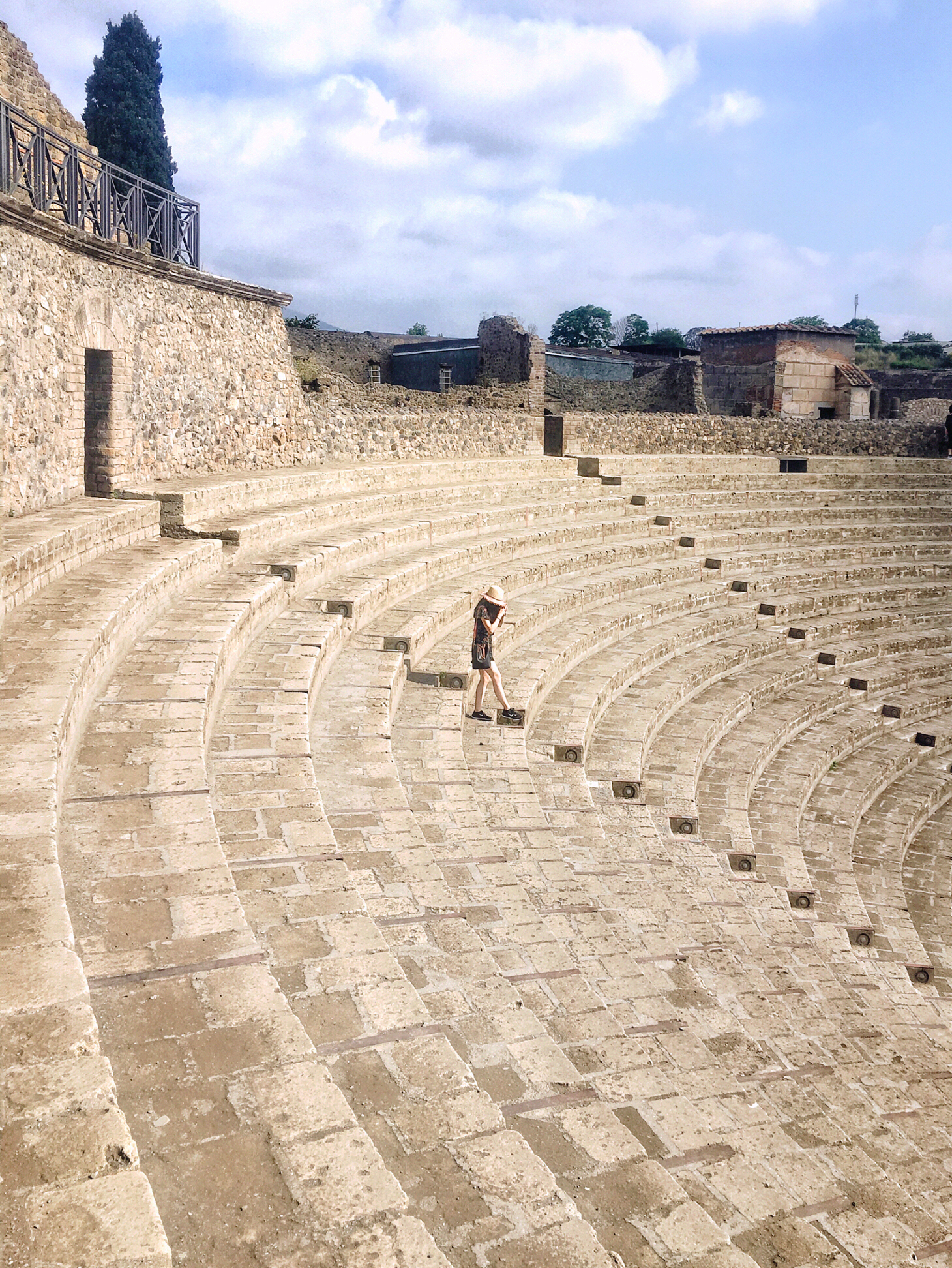

Finally, while you’re in the area, check-out the looming Mount Vesuvius which is the only active volcano in mainland Europe, and the monster that resulted in the ruins of Pompeii. Kevin is somewhat obsessed with volcanoes so we made sure to take the short 800m hike up to the crater of Mount Vesuvius, which offered some great views over the Bay of Naples. Note – while the hike is not very long, there is very little shade offered and the trails can get quite busy. Make sure to bring some sun cover and water for the route!

TIP: You can get to Vesuvius from Pompeii via public bus or the private Vesuvio Express.
Where to eat
Food should feature heavily in any trip to Naples, and must-try foods include sfogliatelle (a ricotta and candied orange shell-shaped pastry) and of course…Neapolitan style pizza! There’s a ton of debate on which pizza joint is the best in Naples, but good options that we tried and were recommended to me by friends living in Naples include Starita Pizza, 50 Kalo, or L’Antica Pizzeria da Michele. If you go to Starita Pizza, make sure to order some pistachio cream donuts for dessert…they are divine!


We personally found L’Antica Pizzeria da Michele to be our favorite pizza place out of the ones we tried…it’s the same pizza place featured in Julia Robert’s movie ‘Eat, Pray, Love’ and let me tell you…the pizza is deserving of the hype. The restaurant is even nicknamed by the locals ‘Temple of the Holy Pizza’. Simplicity and quality are the key words to describe Da Michele…you won’t find an array of toppings to choose from at the restaurant, but that’s okay, because the best pizza we had there was a simple marinara one (who knew that pizza could be good without cheese!?).


Finally, due to it’s seaside location, you’ll find many great seafood restaurants in Naples. Neapolitan “Cuoppo” is a cone of paper filled with fried seafood (oftentimes anchovies), that’s also worth trying.

Procida
What to do
A great day trip option from Naples is the tiny island of Procida. Named ‘Italy’s Capital of Culture’ in 2022, this island has historically lived under the tourist radar, mainly serving as a family vacation getaway from local Neapolitans. You can get to Procida by taking a boat from Naples; either a hydrofoil which takes about 40 minutes and departs from Molo Beverello, or a ferry which takes about 60 minutes and departs from Porta di Massa.

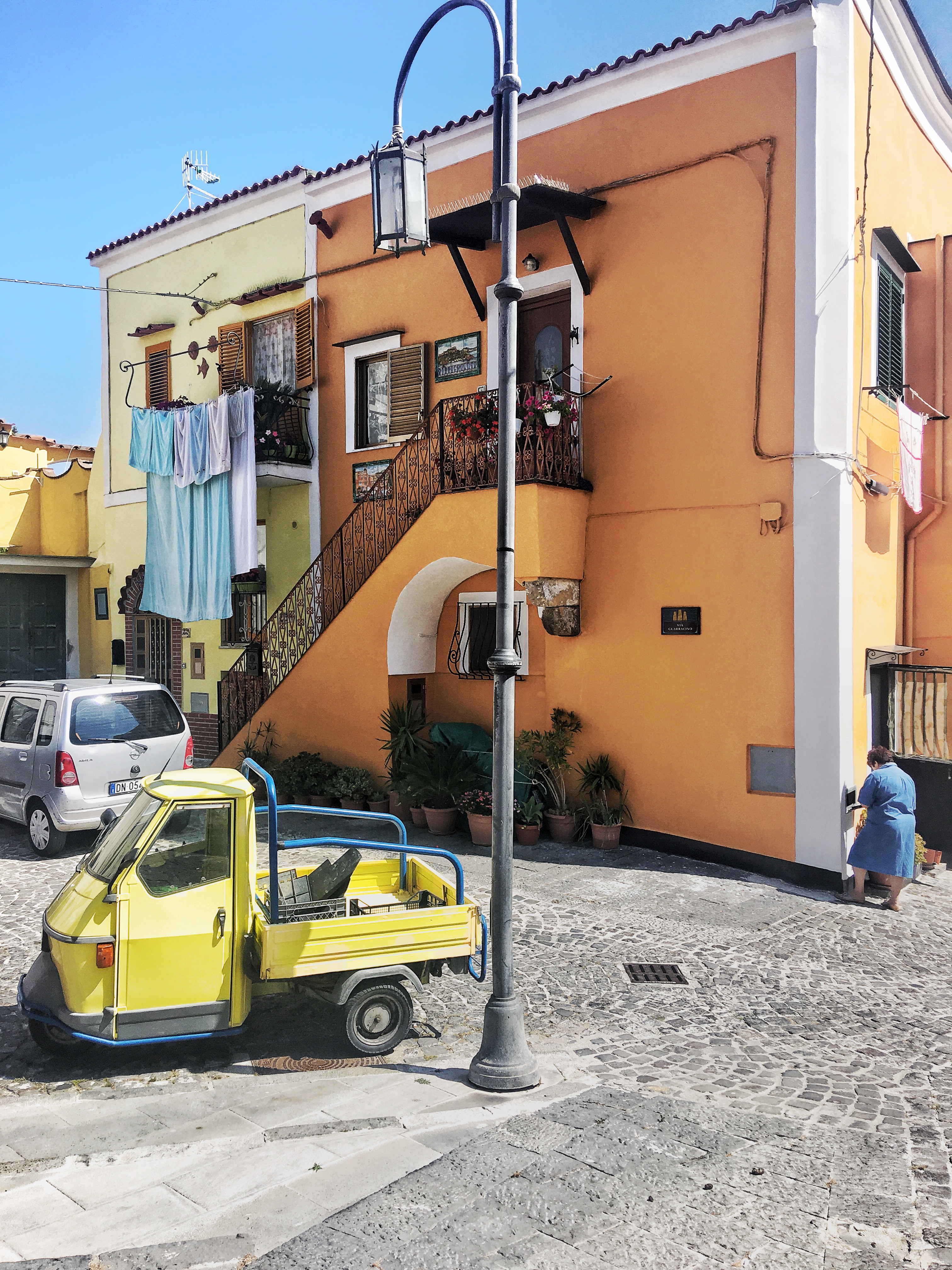
I loved Procida for it’s array of pastel-colored buildings and clean, quiet beaches. While there aren’t very many tourist ‘attractions’, it’s a great place to live la dolce vita (when in Italy right?), and admire the scenery.



Procida is extremely walk-able, and you can make your way around the entire island in just a few hours. We spent a long morning exploring the colorful nooks and crannies of the island, from the rainbow-inspired Marina Corricella (fisherman’s harbor on the North side of the island), to the Terra Murata (the highest point on the island).

TIP: For the best view of the Marina Corricella from above, look for the viewpoint ‘Panoramica sulla Corricella’ on Google Maps.
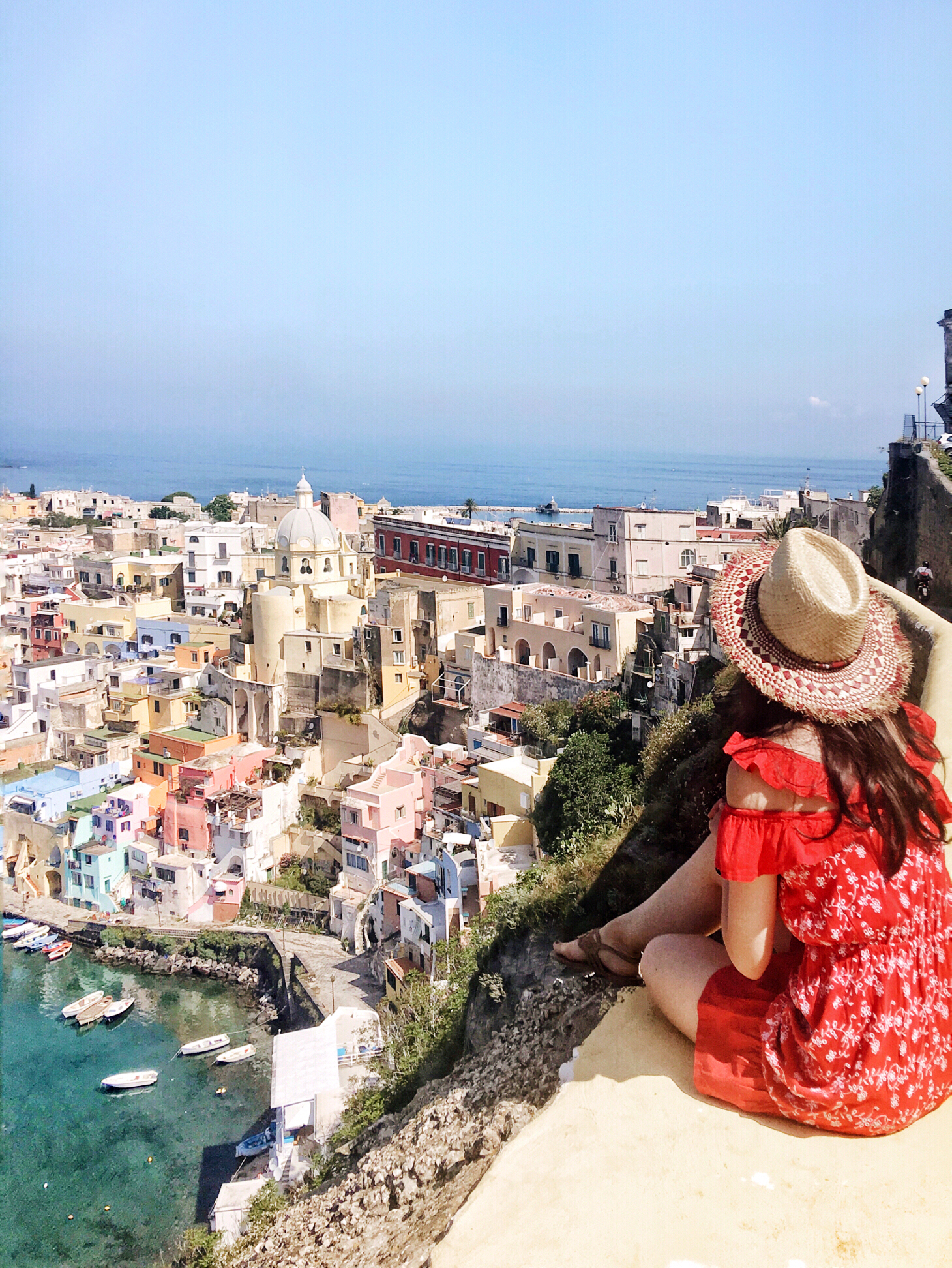

Where to eat
We ate at a little beachside restaurant called Tonino La Conchiglia, and the pasta was amazing! Be sure to ask for a sea view overlooking the yachts. Ristorante La Pergola also comes highly recommended and is known for it’s romantic ambience under the lemon trees (unfortunately, the owners were away on holiday when we visited Procida so we weren’t able to visit).

Sorrento
What to do
Sorrento is a must-stop location – while it’s technically not on the Amalfi Coast but rather on the Sorrentine Peninsula, it’s another popular base or ‘pass through’ for Amalfi Coast visitors due to it’s convenient travel connections to Capri, Positano, Amalfi, and Pompeii. It’s also one of the bigger cities on the coast making it a good travel destination even during the low season.



The best thing to do in Sorrento is to let your feet wander, and get lost in the charming lanes of the Old Town. You can get there by visiting Sorrento’s main piazza (Piazza Tasso), then continue walking down the main shopping street of Corso Italia, and turning right at the end of Corso Italia. We loved exploring the shops, and especially enjoyed the chocolate and limoncello samples at Limonoro (a must-stop for goodies and souvenirs).

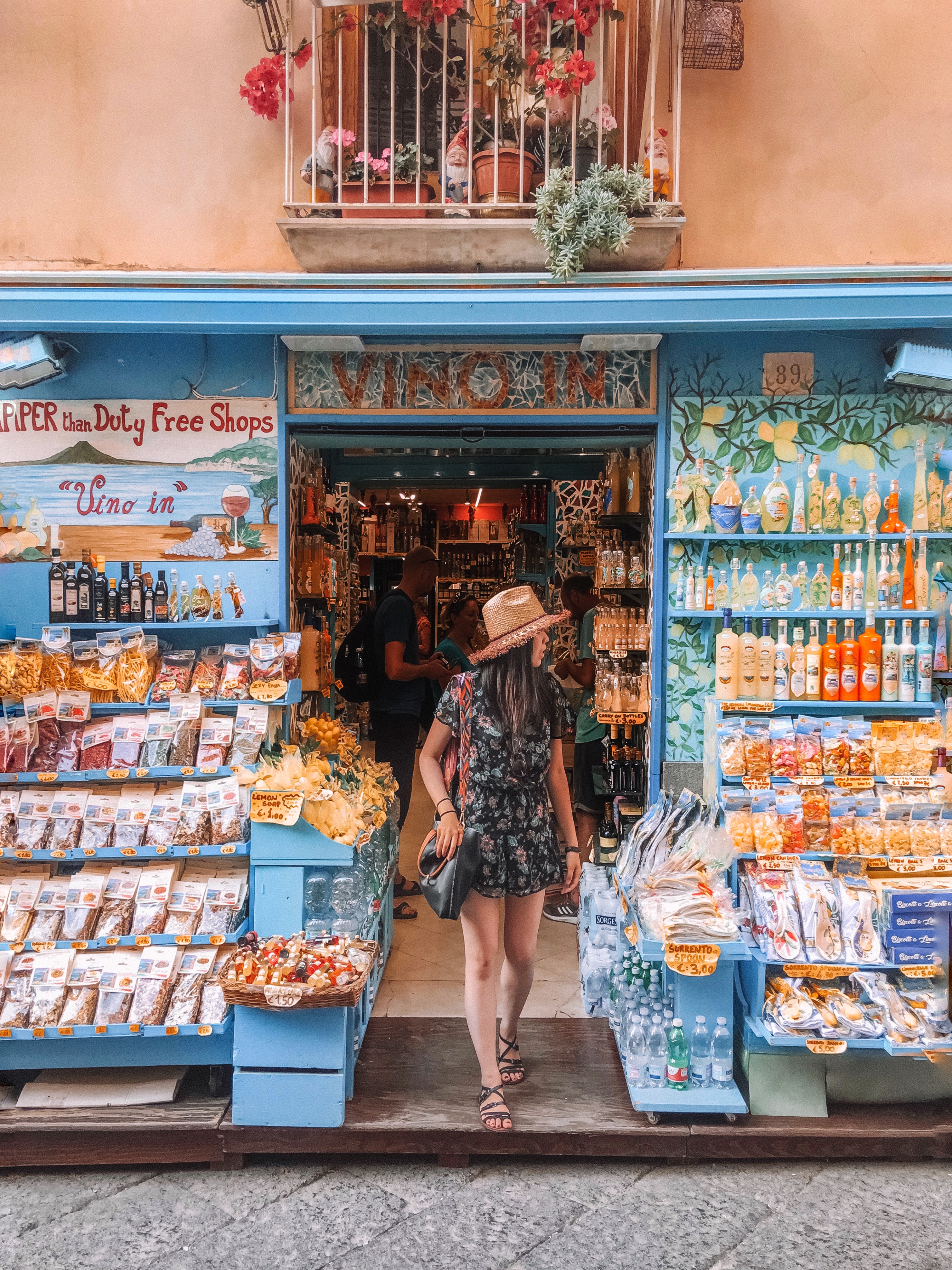
Beneath Sorrento’s Villa Communale next to the port is a number of beach clubs which you can hang out at for a small fee. Most of the beach clubs feature a small sundeck over the water with sun loungers and umbrellas (you can rent them for 12-15 EUR/day), and snack/drink offerings.


Other stops in Sorrento include the Piazza Vittoria which is a beautiful scenic overlook.

Nearby is the Chiostro di San Francesco, which is an architectural gem next to the Villa Communale Park and is famous for it’s stone arches which are oftentimes covered in gorgeous purple and pink bougainvillea.

Where to eat
For food in Sorrento, we made our way to the historic fishing harbor Marina Grande, where pastel-colored buildings, cobblestone lanes, and bobbing boats make your heart sing. While fishermen store their nets and review their catches for the day, you can dine along the waterfront, or sit at one of the many waterside benches for some fun people-watching.


While in Marina Grande, we had a romantic seaside dinner at Da Emilia. Go here if you’re looking for a place with a nice ambiance (and the calamari was pretty good, though the pasta was nothing to write home about).

And of course, when in Sorrento, don’t forget to stop for some Italian gelato. Momi and Gelateria Primavera are both great places for some of that icy goodness.

Positano
What to do
Positano is by far my favorite destination on the Amalfi Coast – there’s just something magical and breathtaking about the colorful layers of Italian homes and villas stacked along the coastline. It’s a must-stop for any Amalfi Coast travel guide. However, getting around Positano is no easy feat…it’s a major leg workout going up and down the hills of the town! We were sweating bullets after getting off the bus from Sorrento, having to lug our luggage to our hotel through narrow passageways and up several different stairwells.
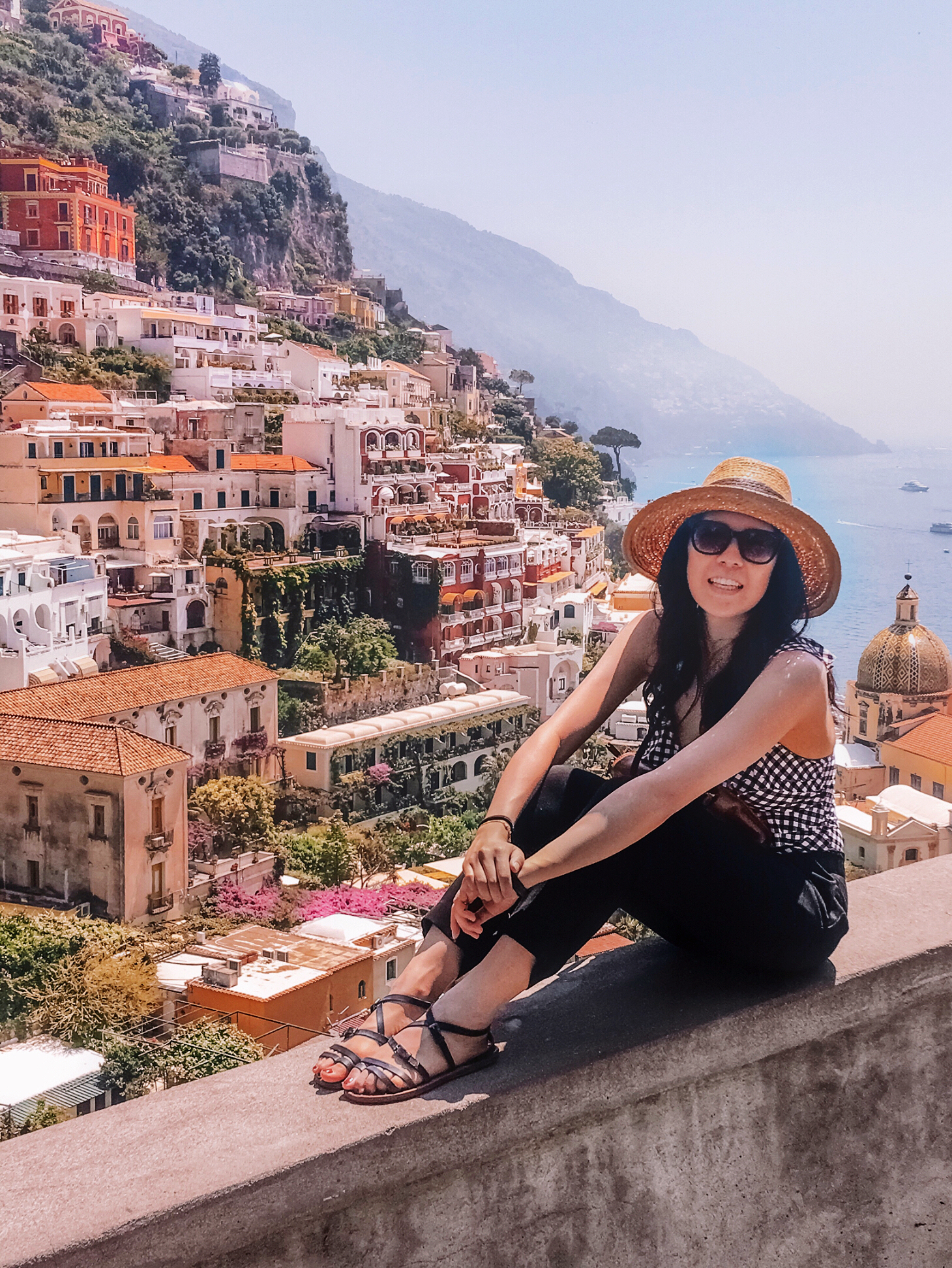

TIP: We stayed at Hotel Casa Albertina and I highly recommend staying at this historic, beautiful hotel. The breakfast spread and view overlooking the water is absolutely gorgeous.

Positano has two main beaches – the primary beach is Spiaggia, where you can rent sun beds or various watersports equipment such as paddleboards and kayaks. The second beach is Fornillo beach which is a bit more family-oriented and can be found by the ferry port. Note – the beaches in Positano are beautiful but they are shingle beaches so can be a bit uncomfortable to lay on unless you rent a lounger.
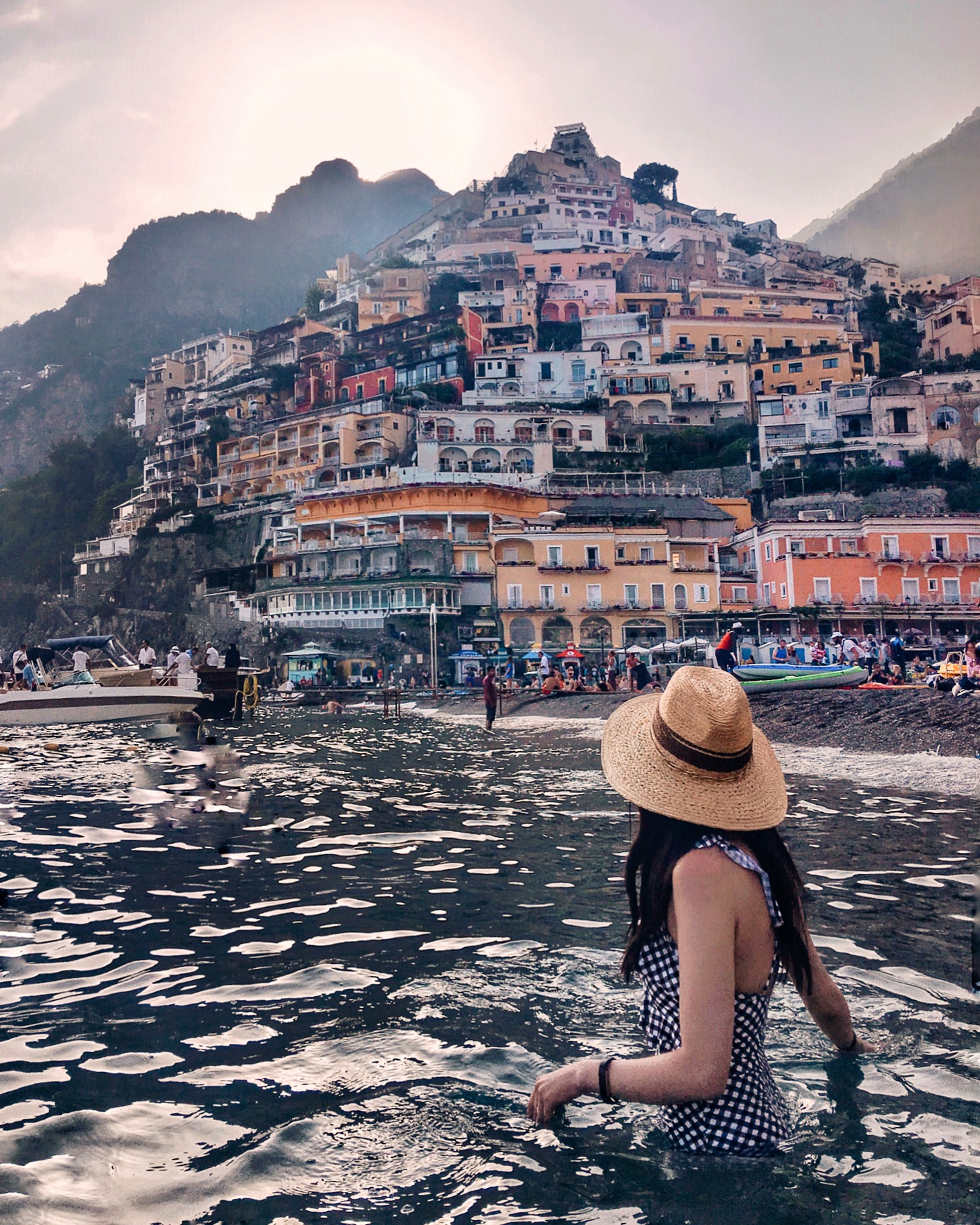
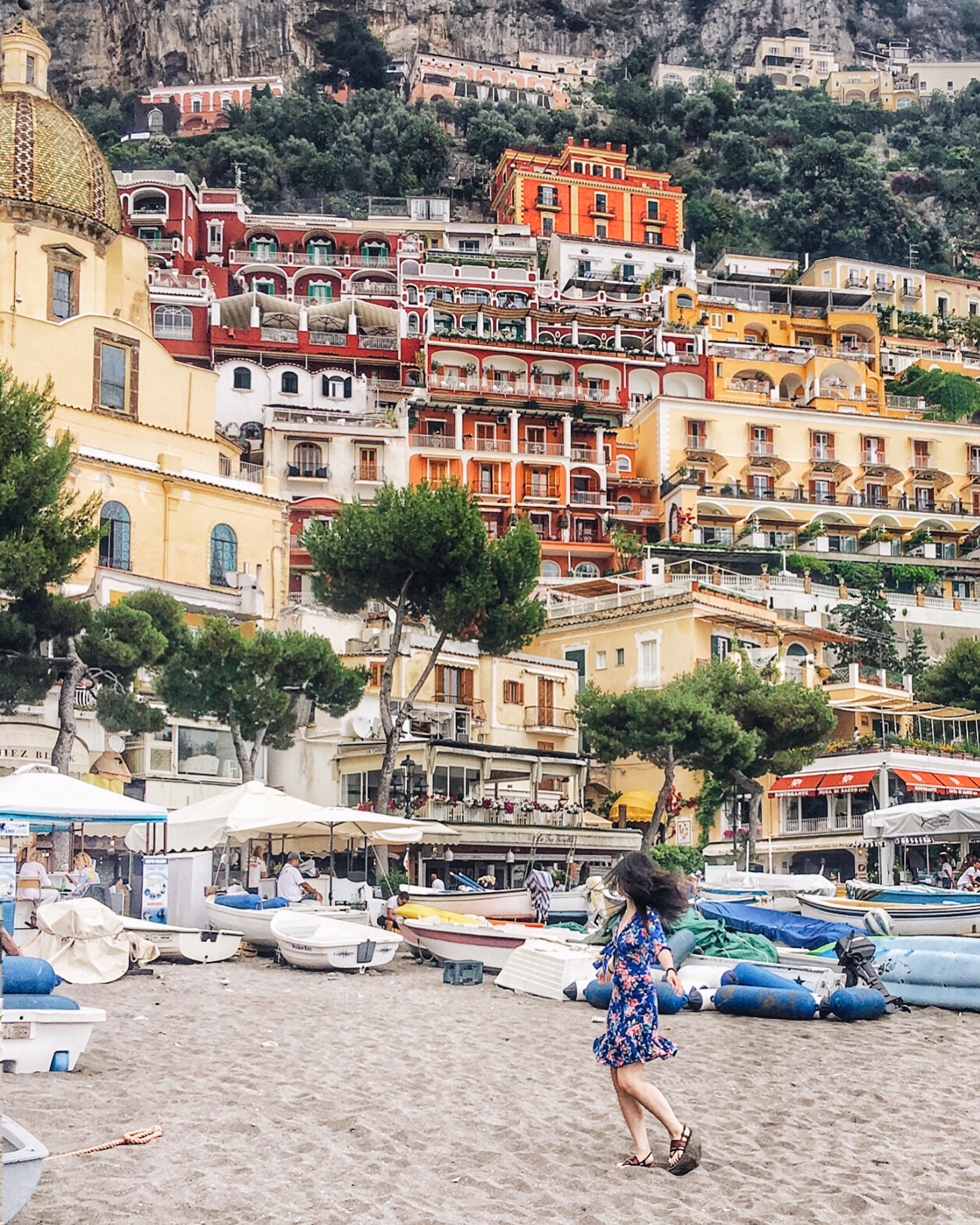


While in Positano, we decided to rent kayaks to get a view of Positano from the water. It was one of the best activities we did on our entire Amalfi Coast trip. Even though the waters were a bit choppy and my shoulders got sun-burned, I won’t ever forget how fun it was to explore the coastline with it’s various secluded beaches and hidden water caves.




Make sure to spend some time exploring the hilly streets of Positano. There are so many beautiful corners covered in pink and purple flowers, and lots of shops selling Italian leather goods, ceramics, and treats.


Nightlife in Positano is relatively tame, but there are plenty of restaurants and bars that are open late if you’re looking for some fun drinks to kick off (or end) the night. Good options for drinks with a view include Franco’s Bar which is located at the glamorous Le Sirenuse hotel (the best time to go is during sunset, although try to go early if you want a seat at the bar) or Il San Pietro.


When in Positano, you can also take a day trip to Capri (see next section ‘Capri’ below for more details!). I also highly recommend hiking the infamous ‘Path of the Gods’ hike from Positano to Amalfi (covered in the ‘Amalfi’ section below).
Related Post: 15 Photos That Will Inspire You to Visit Capri, Italy
Where to Eat
For beachside dining, look no further than Chez Black. The food is decent (try the sea urchin pasta!) albeit pricey, but definitely go there to sip on a bright Aperol spritz.


If you only have one place to eat at while in Positano, try to make it to La Tagliata. This family run restaurant offers incredible views of the Amalfi Coast, and the food tastes as though it’s been made with love. We made reservations for 8pm and the restaurant picked us up at a shuttle stop near the Hotel Poseidon so we didn’t have to make the trek up the hill to the restaurant location.
There’s no menu at La Tagliata – expect a casual selection of starters, pasta, grilled meats based on what is seasonally available. The best part of the meal….the unlimited wine! I swear, the restaurant owners were just continuously topping up our wine glasses and of course, we weren’t complaining.


For something a bit more upscale and romantic, visit Donna Rosa. This family-run honeymoon hot spot features refined Italian pastas and seafood dishes (it’s also one of Jamie Oliver’s favorite restaurants in Italy!). Side story – don’t be like us and show up 20 minutes late to your dinner reservation at Donna Rosa. We had underestimated how long it would take for us to walk uphill to the restaurant from our hotel and ended up showing up to this fine dining establishment with our shirts absolutely drenched in sweat…it was SO embarrassing. Thankfully, the restaurant was kind enough to keep our dinner reservation…
Capri
Capri is a special place – so special it deserved it’s very own blog post. We visited Capri as part of our Amalfi Coast trip (day trip from Positano) and loved exploring this glamorous island. From the turquoise blue waters to the dramatic rock formations, you definitely want to visit Capri while you’re in the region. Check out this blog post to read more.
Related Post: 15 Photos That Will Inspire You to Visit Capri, Italy
Amalfi
What to do
Our last stop was the town of Amalfi, the town that gives its name to the area. Sandwiched between turquoise waters and steep mountains, this historic town is well-worth visiting and features gorgeous medieval architecture which are remnants of Amalfi being one of the 4 Maritime cities of the Republic of Italy (and with that designation came wealth, power, and beauty).



TIP: We stayed at the Villa Lara Hotel in Amalfi and loved the generous breakfast spread overlooking the valley.

The primary focal point in Amalfi is the Piazza del Duomo in the city center, and the surrounding piazza with its elegant sidewalk cafes and local shops. This Byzantine style church is a beautiful structure and well worth taking the sixty steps upwards to see the piazza from above. I loved the gray and white striped walls, and the high arched windows!
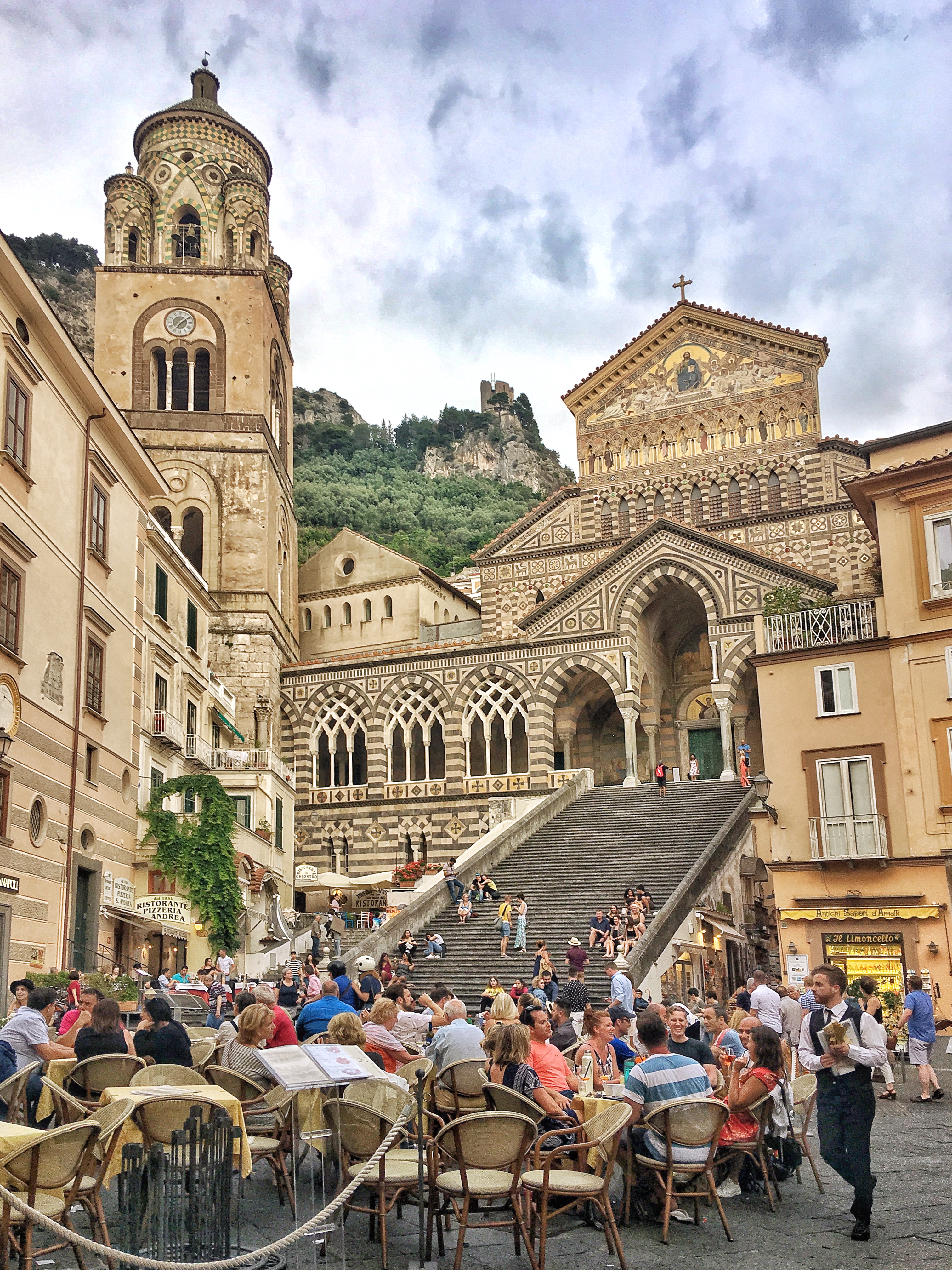



Located just off Amalfi’s main street in Piazza dello Spirito Santo is a quirk nativity fountain called Fontana Cap e Ciuccio that’s also worth stopping by. It originated as a nativity scene but over the years has been expanded upon with a variety of figurines.


We also took the ten minute walk from Amalfi to the nearby fishing village of Atrani. The path is just above the coast road, and even though it’s only a short distance from Amalfi, offers a totally different atmosphere. You won’t find hustle and bustle in Atrani…instead, you’ll see locals going about their business and have the opportunity to roam a plethora of quiet and narrow winding residential streets.

Finally, when on the Amalfi Coast, you should hike the infamous ‘Path of the Gods‘. This moderate 5-mile hike (one way) is one of my favorite things we did on the trip, and starts in the small village of Bomerano and ends in Nocelle (above Positano), or vice versa. Both ways offer beautiful views of the coastal towns and hillside vineyards. You can extend your hike by ending it in Positano (below Nocelle, take a steep staircase of 1,500 steps down from the path towards the main town).

Related Post: Visiting Cassis and Calanques National Park
We chose to start the Path of the Gods hike in Bomerano, and took a 30-minute bus ride from Amalfi to get there (Amalfi is the main hub for buses in the area). Starting from Bomerano meant that we could hike downhill rather than uphill, and then end the hike in Positano where we could re-fuel with a granita or cold drink. While in Bomerano, we stopped at the main deli in the town to pick up a few sandwiches to eat on the trail – I highly recommend doing this as the hike will take roughly 3-4 hours so you’ll want something to help you refuel. I’m still dreaming about the smoked mozzarella and salami sandwich I got from that deli!


TIP: The bus you’ll take from Amalfi will be labeled ‘Agerola’ or ‘Agerola (Bomerano)’. Agerola is the municipality, and Bomerano is a small village in Agerola.
The hike itself is gorgeous (I love a good coastal hike!). Imagine…hills and hills of terraced vineyards, the smell of olive and lemon trees, clusters of secluded Italian towns, the endless blue of the ocean…



Where to Eat
You can’t visit Amalfi without stopping by the famous dessert shop Pasticceria Pansa for their creamy lemon cakes (delizie al limone). You can take your treats to dine al-fresco, so we shared several desserts and drinks in the main piazza out front. It was wonderful!

Or, stop by C.I.C.A. while cruising the main street of Amalfi for a hand-held cone of fresh fried seafood, a local street food favorite!

We also had a delicious seafood and pasta dinner at the romantic Taverna Buonvicino (ask for a seat outdoors for the ambiance, but beware you may get a few local kittens pawing at your feet for scraps!).

Related Post: Best Towns to Visit in Lake Garda
Related Post: A Foodie’s Weekend Guide to Emilia-Romagna
Related Post: Planning a Winter Trip to Florence

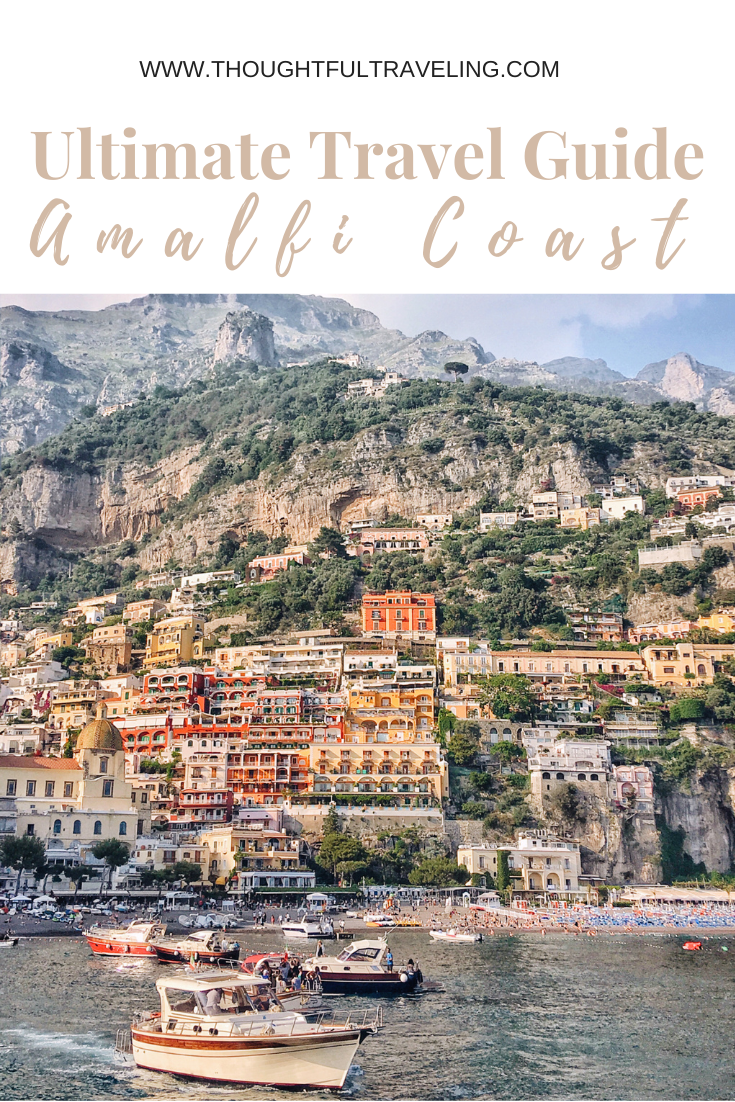

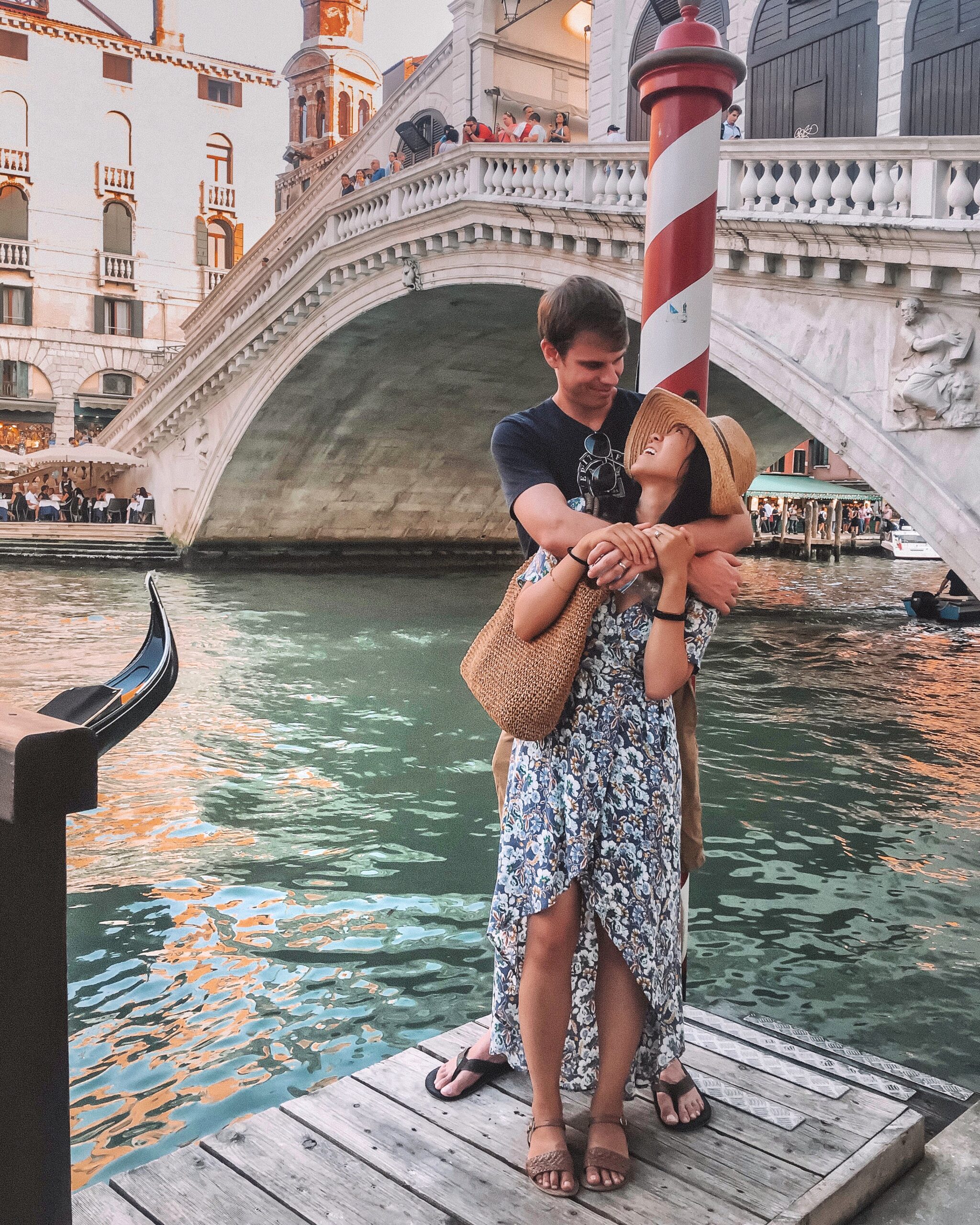



Leave a Reply